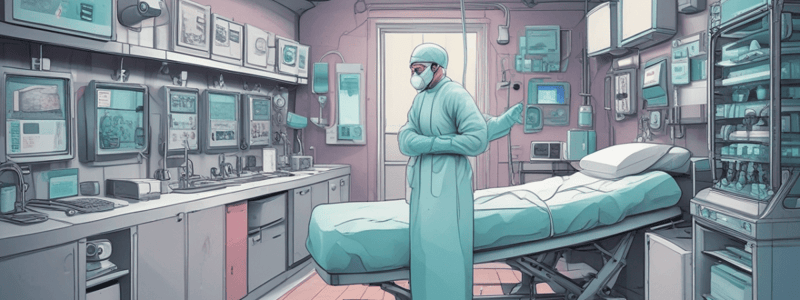Podcast
Questions and Answers
What should be checked on each device before assembly?
What should be checked on each device before assembly?
- Tightness of all screws
- Free movement of all parts and non-sticking joints (correct)
- Proper meshing of teeth and no overlap of clamping RMD
- All of the above
What is the purpose of the barcode label scanning in the IAP room?
What is the purpose of the barcode label scanning in the IAP room?
- To track the devices through the decontamination process (correct)
- To log and store the information for each tray
- To generate a unique barcode label for each tray
- To produce a packing list for each tray
What is the consequence of not checking the screws on jointed RMD during cleaning?
What is the consequence of not checking the screws on jointed RMD during cleaning?
- The devices may become loose during assembly
- The devices may become stuck during assembly
- The devices may become damaged during the cleaning process
- The devices may become loose during the cleaning process (correct)
What is the benefit of using a computerized track and trace system in the CSSD?
What is the benefit of using a computerized track and trace system in the CSSD?
What is generated each time a new processing cycle begins in the computerized track and trace system?
What is generated each time a new processing cycle begins in the computerized track and trace system?
What is used in place of a computerized track and trace system in some CSSDs?
What is used in place of a computerized track and trace system in some CSSDs?
What is the primary reason for wearing protective clothing in the IAP room?
What is the primary reason for wearing protective clothing in the IAP room?
What is the recommended frequency for changing freshly laundered scrub suits?
What is the recommended frequency for changing freshly laundered scrub suits?
What type of hat or hood is worn in the IAP room?
What type of hat or hood is worn in the IAP room?
What is the correct disposal method for headgear and beard masks after use?
What is the correct disposal method for headgear and beard masks after use?
What type of jewelry is allowed to be worn in the IAP room?
What type of jewelry is allowed to be worn in the IAP room?
What is the rule regarding the use of shoes in the IAP room?
What is the rule regarding the use of shoes in the IAP room?
What is the primary purpose of packaging in a CSSD environment?
What is the primary purpose of packaging in a CSSD environment?
What is the main advantage of sequential wrapping over simultaneous wrapping?
What is the main advantage of sequential wrapping over simultaneous wrapping?
What is the primary benefit of using a Square Fold Technique?
What is the primary benefit of using a Square Fold Technique?
What is the characteristic of Spunbond-meltblown-spunbond (SMS) fabrics?
What is the characteristic of Spunbond-meltblown-spunbond (SMS) fabrics?
What is the primary purpose of using a sterilization wrap?
What is the primary purpose of using a sterilization wrap?
What is the characteristic of a good seal in sterilization wrapping?
What is the characteristic of a good seal in sterilization wrapping?
What is a significant improvement in rigid reusable containers compared to previous versions?
What is a significant improvement in rigid reusable containers compared to previous versions?
What is a key consideration when using rigid containers for sterilization?
What is a key consideration when using rigid containers for sterilization?
Why is it important to examine the filter plate of a rigid container?
Why is it important to examine the filter plate of a rigid container?
What is a benefit of using rigid containers for sterilization?
What is a benefit of using rigid containers for sterilization?
What should be considered when packing a rigid container for sterilization?
What should be considered when packing a rigid container for sterilization?
What happens if the filter plate of a rigid container is damaged or dislodged?
What happens if the filter plate of a rigid container is damaged or dislodged?
What is the primary purpose of using a tip protector during sterilization?
What is the primary purpose of using a tip protector during sterilization?
Why is it important to avoid folding the inner pouch during double pouching?
Why is it important to avoid folding the inner pouch during double pouching?
What is the recommended method for labeling packages before sterilization?
What is the recommended method for labeling packages before sterilization?
What information should be included on the label of a sterilized package?
What information should be included on the label of a sterilized package?
Why is complete and accurate labeling of packages important?
Why is complete and accurate labeling of packages important?
What is the purpose of double pouching in the sterilization process?
What is the purpose of double pouching in the sterilization process?
Flashcards
Device Inspection
Device Inspection
The process of checking a medical device for proper functionality and ensuring it's safe to use.
Lubrication
Lubrication
Lubricating moving parts of a medical device with water-based solution to prevent them from sticking.
Free Movement
Free Movement
Ensuring all parts of the device, especially those with joints, move freely and smoothly.
Clamping Edges
Clamping Edges
Signup and view all the flashcards
Teeth Mesh
Teeth Mesh
Signup and view all the flashcards
Screw Tightening
Screw Tightening
Signup and view all the flashcards
Track and Trace Systems
Track and Trace Systems
Signup and view all the flashcards
Barcode Label
Barcode Label
Signup and view all the flashcards
Handheld Barcode Readers
Handheld Barcode Readers
Signup and view all the flashcards
Clothing Change Area
Clothing Change Area
Signup and view all the flashcards
Protective Clothing
Protective Clothing
Signup and view all the flashcards
IAP Room
IAP Room
Signup and view all the flashcards
Manager's Role in Protective Clothing
Manager's Role in Protective Clothing
Signup and view all the flashcards
Daily Scrub Suit Change
Daily Scrub Suit Change
Signup and view all the flashcards
Head Cover
Head Cover
Signup and view all the flashcards
Headgear and Beard Masks
Headgear and Beard Masks
Signup and view all the flashcards
Waste Stream for Headgear
Waste Stream for Headgear
Signup and view all the flashcards
Stud Earrings
Stud Earrings
Signup and view all the flashcards
Makeup and Jewelry Ban
Makeup and Jewelry Ban
Signup and view all the flashcards
Complete Enclosure
Complete Enclosure
Signup and view all the flashcards
Protection from Damage
Protection from Damage
Signup and view all the flashcards
Seal Integrity
Seal Integrity
Signup and view all the flashcards
Resistance to Tears
Resistance to Tears
Signup and view all the flashcards
Tamper Proof
Tamper Proof
Signup and view all the flashcards
Air Removal
Air Removal
Signup and view all the flashcards
Sterilization Flat Wraps
Sterilization Flat Wraps
Signup and view all the flashcards
Sequential Wrapping
Sequential Wrapping
Signup and view all the flashcards
Simultaneous Wrapping
Simultaneous Wrapping
Signup and view all the flashcards
Square Fold
Square Fold
Signup and view all the flashcards
Envelope Fold
Envelope Fold
Signup and view all the flashcards
Rigid Reusable Containers
Rigid Reusable Containers
Signup and view all the flashcards
Disassembly for Cleaning
Disassembly for Cleaning
Signup and view all the flashcards
Sterilization Method Compatibility
Sterilization Method Compatibility
Signup and view all the flashcards
Compatibility with Cleaning Agents
Compatibility with Cleaning Agents
Signup and view all the flashcards
Storage Configuration Compatibility
Storage Configuration Compatibility
Signup and view all the flashcards
Penetration of Sterilizing Agent
Penetration of Sterilizing Agent
Signup and view all the flashcards
Package Labels
Package Labels
Signup and view all the flashcards
Labeling Information
Labeling Information
Signup and view all the flashcards
Study Notes
Device Inspection and Assembly
- Devices should be checked for free movement of all parts and non-sticking joints.
- A water-based lubricant may be used if required, following the IFU for dilutions and application.
- Check that the edges of clamping RMD meet with no overlap and that teeth mesh together properly.
- Ensure all screws on jointed RMD are tightened, as they may become loose during cleaning.
Track and Trace Systems
- Many CSSDs use computerized track and trace systems to accurately track devices and device trays throughout the decontamination process.
- The system uses handheld barcode readers connected to PCs to log and store information for each tray.
- A unique barcode label is generated for each tray, containing the serial number specific to that tray and process.
Dress Code Requirements
- Staff must pass through a clothing change and hand-wash area when moving between dirty and clean areas.
- Protective clothing is worn by personnel entering the IAP room to reduce the risk of contamination.
- Managers ensure protective clothing is available, and personnel are responsible for its correct use and disposal.
Protective Clothing
- Specialists in the IAP room wear a freshly laundered scrub suit, changed daily or when visibly soiled or wet.
- A clean, single-use, low-lint surgical hat or hood is worn to confine all hair.
- Headgear and beard masks are discarded in the appropriate waste stream after use.
- Stud earrings are allowed if totally confined within the head cover.
- Make-up and jewelry, apart from a wedding band, are not worn in the IAP.
Packaging Requirements
- Packaging should allow for complete and secure enclosure of the item(s).
- Packages should protect the contents from physical damage due to stacking or compression.
- Packages should have a method of sealing that results in a complete seal and provide adequate seal integrity.
- Packages should be resistant to tears, abrasions, and punctures.
- Packages should ensure the seal is tamper-proof and can only be sealed once.
- Packages should permit adequate air removal.
Sterilization Flat Wrap
- Sterilization flat wraps are made of nonwoven Spunbond-meltblown-spunbond (SMS) fabrics and are designed as single-use products.
- They are available in a variety of sizes and weights.
- Two wrapping techniques are used: sequential wrapping and simultaneous wrapping.
Wrapping Techniques
- Sequential wrapping involves wrapping two layers of wrap material individually using a fold technique.
- Simultaneous wrapping involves wrapping both layers of wrap material together simultaneously.
- Square fold and envelope fold techniques are used with sequential and simultaneous wrapping.
Containers
- Rigid reusable containers are making a comeback and can be cost-effective if used properly.
- Containers should be easily disassembled for cleaning, drying, and storage.
- Containers should be suitable for the method of sterilization being used.
- Containers should be compatible with the cleaning method and cleaning agent being used.
- Containers should be suitable for the storage configuration, lockable, tamper-proof, and non-resealable.
- Containers should be packed to allow for penetration of the sterilizing agent.
Package Labeling
- All packages should be labeled before sterilization with complete and accurate information.
- Labels should include package contents, lot number, sterilization date, pack complete name, assembler/packager name, requesting department, sterilizer number, and used cycle.
- Labeling information should be written on sterilization tape, commercially available adhesive labels, or in the plastic side of peel pouches.
Studying That Suits You
Use AI to generate personalized quizzes and flashcards to suit your learning preferences.




